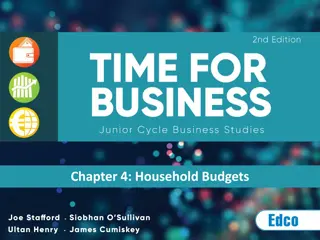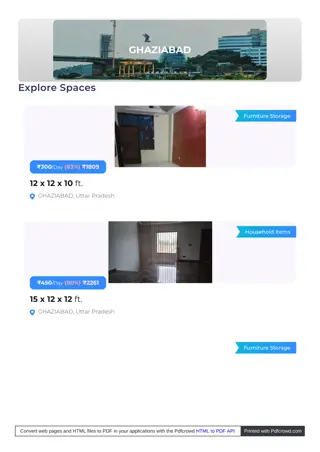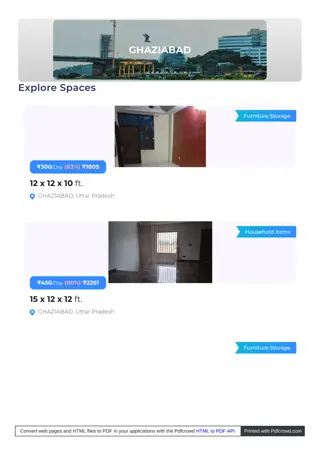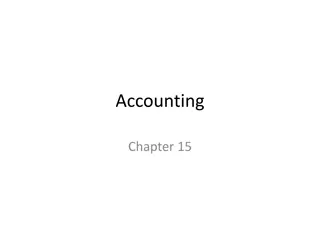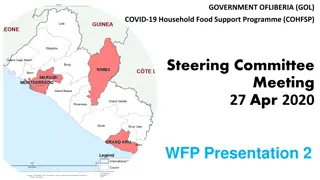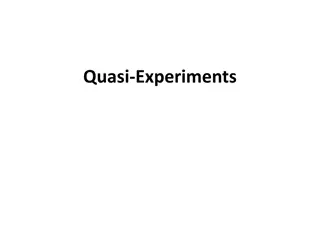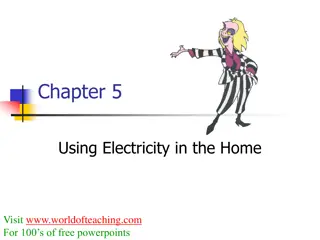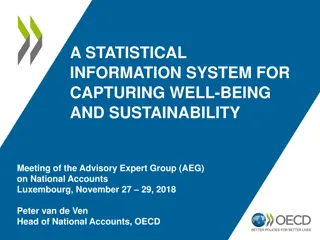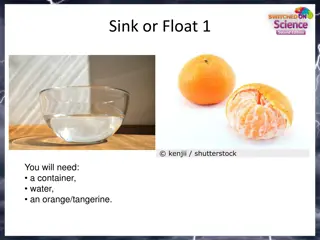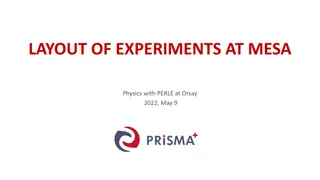Fun Science Experiments to Do at Home with Household Items
Explore engaging science experiments using everyday household items like vegetable oil, vinegar, food coloring, and more. Create DIY lava lamps, observe how a leaf breathes, make a water xylophone, create rainbow paper, and discover the walking water phenomenon. These hands-on activities are perfect for curious minds of all ages to enjoy and learn from.
Download Presentation

Please find below an Image/Link to download the presentation.
The content on the website is provided AS IS for your information and personal use only. It may not be sold, licensed, or shared on other websites without obtaining consent from the author. Download presentation by click this link. If you encounter any issues during the download, it is possible that the publisher has removed the file from their server.
E N D
Presentation Transcript
Fun Science Experiments to do at Home Credit @MrsBpriSTEM
What you will need: Vegetable oil Vinegar Food colouring Bicarbonate of soda Tall glass/bottle Spoon Small cup DIY lava lamps 1. Add three spoons of bicarbonate of soda into the tall glass or bottle 2. Fill two thirds of the container with oil BUT DON T MIX! 3. In the small cup, add some vinegar and several drops of food colouring. 4. Slowly add drops of your coloured vinegar into your oil/bicarb mixture and watch your lava lamp come to life! Try adding different colours to your lamp.
How does a leaf breathe? What you will need: Glass bowl Fresh leaves (just removed from plant/tree) Lukewarm water Small stone Magnifying glass 1. Cut a green leaf off a plant/tree. You need fresh leaves, not leaves from the ground. 2. Add lukewarm water to a glass bowl. 3. Place the leaf in water and put a small stone on top so the leaf is fully submerged. 4. Put the bowl in the sun and wait for 2-3 hours. 5. Watch as little air bubbles form on the top of the leaves. You might need a magnifying glass.
What you will need: Glass jars/bottles (all same size) Water Measuring jug Spoon metal or wooden Food colouring (optional) Water xylophone 1. Carefully measure different quantities of water and pour them into each jar/bottle. Make sure each jar has slightly more water than the last. 2. If you want, add food colouring. 3. Use your spoon to play your xylophone. Experiment on how hard to beat the glass to get the best sound. (Be careful with the glass!)
What you will need: Black paper/card (or try other colours to compare) Clear nail polish Bowl Water Rainbow paper 1. Cut your black paper/card into a small rectangle. Start small until you get the hang of it then you experiment with bigger pieces. 2. Fill a bowl with water. 3. Drop 1 drop of clear nail polish on top of the water. 4. Quickly dip a piece of black paper into the water and pull it out again. 5. Leave it for a few minutes to dry.
What you will need: Two cups/glasses String Water Food colouring (optional) Tape Walking water 1. Tape one end of string inside the bottom of a glass. Fill the other glass with water (and food colouring if you want) and put the free end of the string in the water (not taped) Lift the cup with water up above the other, but not directly over it. Hold it far enough for the string to be taut. Be careful not to pull the string out of either cup. Slowly pour the water out of the top cup onto the string. Keep it taut! Now, soak the entire string in water and try again. You should be able to pour the water straight from the top cup to the bottom cup through the string. 2. 3. 4. 5.
What you will need: Plate Candle Water Food colouring Glass Underwater candle 1. Add a couple drops of food colouring to about half a glass of water. This will make the movement of water later on easier to see. 2. Pour the coloured water onto a plate. 3. Put the candle in the middle of the plate then light it ADULT SUPERVISION NEEDED 4. Turn the glass over and lower it over the candle. Place it on the plate in the water and let go. Try it with different sizes of glass to see if this affects the amount of water.
Grow your own crystals 1. The day before starting your sugar experiment, cut a piece of string a little longer than your jars. Tie one end of the string to a straw (skewer or pencil) and tie a knot in the other end. Wet the string, coat in sugar and leave to dry overnight. The following day, add four cups of sugar to one cup of water and heat in a pan until boiling - ADULT SUPERVISION. Also add food colouring if you want. Stir until the sugar has dissolved. Remove from heat and leave to cool slightly. Pour the mixture into your jars lower in the string and leave in a safe place. Leave the sugar to form crystals roughly a week. What you will need: 4 cups sugar 1 cup boiling water Food colouring 3 jars/glasses Thread or string 3 skewers, straws or pencils 2. 3. 4. 5.
What you will need: Two glass jars Hot water Bicarbonate of soda Two paper clips String or wool Small plate Grow hanging crystals 1. Pour hot water into the two jars and stir bicarbonate of soda until no more will dissolve (around 6- 7 teaspoons). When a layer forms at the bottom of the jars, this means no more will dissolve. 2. Tie a paper clip to each end of the piece of wool/string and place each end in each jar so it hangs between. 3. Put a plate underneath the wool between the jars. 4. Leave for around a week. Crystals will begin to form along the wool hanging down like stalactites. You may even get stalagmites forming on the plate.
What you will need: A glass/jar Shaving foam (not the gel variety) Food colouring Water Small bowl Pipette or spoon Rain cloud in a jar 1. Fill the glass/jar with water, leaving about 2 inches at the top. 2. Add the saving foam so it looks like a cloud and let it stand for a few minutes until it is fully sitting on top of the water. 3. In a small bowl, add some water and food colouring. 4. Use a pipette to add drops of the water mixture to the top of the shaving cream cloud. 5. Observe your rain as it breaks through the cloud.
What you will need: Balloon Water Jar Matches Paper Balloon in a jar 1. Fill the balloon with water so that it is just too large to fit inside the jar and rests on top. Notice how the balloon won t fit through the opening. Do you think it is possible for the balloon to enter the jar? Light a piece of paper (ADULT SUPERVISION) and quickly drop it into the jar. Place the balloon on top of the jar. The balloon will start to shake a little, then be sucked into the jar. It probably won t be sucked in all the way but halfway into the jar. 2. 3. 4.
What you will need: Paper cup Constellation template Pin Torch Constellation cups 1. Cut out your favourite constellation from the template provided see next slide. 2. Stick the template to the bottom of the cup. 3. Use a pin to poke through the dots on your template to create your constellation. 4. In a darkened room, shine your torch/light through the cup to project your constellation onto the wall.
What you will need: A teabag (the folded type that has a string and label) Matches/lighter Plate Scissors Teabag rocket 1. Cut the top off your teabag and empty out the tea leaves. 2. Unfold the teabag and hollow it out using your finger. 3. Stand our teabag upright onto the plate and light both sides (at the top) with matches/lighter (ADULT SUPERVISION). 4. Stand back as the flame burns down your rocket and then it takes off!
Upside down glass of water trick What you will need: Glass Card (big enough to cover the opening of your glass) Water 1. Check the card is big enough to completely cover the opening of the glass. 2. Fill your glass with water almost to the top. 3. Place the car over the opening of the glass and tip the glass upside down (with your hand on the card). 4. When you re feeling brave, remove your hand. Make sure you practice over the sink or outside a few times. 5. Mastered the technique? Are you willing to do the trick over your own head?
Balloon powered water pump What you will need: Plastic bottle Scissors Straw Blu-tack/plasticine/glue Balloon Peg Glass/bowl 1. Cut a hole half way up the plastic bottle ask an adult to help. 2. Push the straw through the hole and seal with blu- tack/plasticine/glue. 3. Fill the bottle about two thirds full with water. 4. Blow up a balloon, twist and secure it with a peg and carefully attach it to the top of the bottle. 5. When you re ready, remove the peg and watch the water shoot out into the glass or bowl. 6. Use the peg like a tap.
What you will need: Tissue paper Balloon Tape Scissors Pens to add detail on your ghost Floating ghosts 1. Draw a ghost (or any other creature) on your tissue paper and cut it out. 2. Tape the bottom of your ghost to the table with a small amount of tape. 3. Blow up the balloon and tie it. 4. Rub the balloon very quickly on your hair or jumper for 10- 15 seconds. 5. Slowly bring the balloon near the ghost and the ghost should rise towards the balloon.
What you will need: Balloon Wooden skewer Oil or liquid soap Unpoppable balloon 1. Inflate the balloon until it s nearly full size and then let out about one third of the air out. 2. Tie a knot in the end of the balloon 3. Look at the balloon there s a thick area of rubber at both ends of it (where you tied the knot and at the opposite end). 4. Coat the wooden skewer with a few drops of vegetable oil or dish soap. 5. Push the skewer through the thicker area of rubber at each end of the balloon.
What you will need: Kitchen roll/paper towel Felt tip pens Small bowls of water Paper clip Thread Grow a rainbow 1. Cut the kitchen roll into the shape of a rainbow. 2. Colour a rainbow with felt tips about 2cm up on both sides. 3. Attach your paper clip to the top and tie a piece of thread to it. This will give you something to hold your rainbow with. 4. Fill each container with water. 5. Hold your rainbow with the ends slightly submerged in the water and watch your rainbow grow.
What you will need: Sharp pencils or skewers A sealable bag Water The leak-proof bag 1. Make sure the pencils/skewers are sharp before you begin. 2. Fill three quarters of your bag with water and seal it. 3. Holding the top of the bag with one hand, use the other hand to push a pencil/skewer right through to the other side. Like magic, there are no leaks! 4. Repeat with several pencils/skewers making sure they are pushed through in different places on the bag. 5. How many pencils/skewers can your bag hold?
What you will need: Lemon juice Paint brush Cup Paper Candle Bowl of water Invisible ink 1. Add about 1 tablespoon of lemon juice to the cup. Freshly squeezed or bottled will work. 2. Soak the pain brush in lemon juice and use it to write a message on your paper. 3. Once it is dry, it will be invisible. 4. Carefully hold up your paper over a lit candle (ADULT SUPERVISION) to reveal your message. Be careful not to set fire to the paper have a bowl of water to hand just in case. 5. Try different fruit juices compare the results. Do they all work?
What you will need: Tin/tub Flour Chocolate powder Rocks different sizes Moon s craters 1. Fill a tin/tub with about an inch of flour. 2. Use a sieve to add a thin layer of chocolate powder. 3. From a height, drop different sizes of rock and watch the craters form. 4. What do you notice about different sized rocks dropped from the same height? 5. What happens if a rock is thrown at an angle?
DIY seed bombs 1. Mix the flour and compost until it has combined. Add the water and mix until it is the consistency of playdough. If it is too wet, add more flour. If it is too dry, add more water. You can add chilli powder to deter animals from eating them use gloves! Add the seeds and distribute evenly. Once you have a good consistency, turn your dough onto a floured surface. Take small pieces of the dough and roll into balls. If the dough is a bit too sticky, roll it in the extra flour you have on the surface. Leave the seed bombs to dry it usually takes a couple of days. When dry, throw them in an outdoor space not on to private land! 2. 3. 4. 5. 6. 7.
Nature scavenger hunt 1) Print off the colour wheel, stick it to a piece of card and cut it out. 2) Have 12 pegs to hand maybe peg them to your top so you don t lose them! 3) Head outside and get hunting. 4) Add a peg to the colour on the wheel each time you see that colour in nature. 5) Can you find them all?




